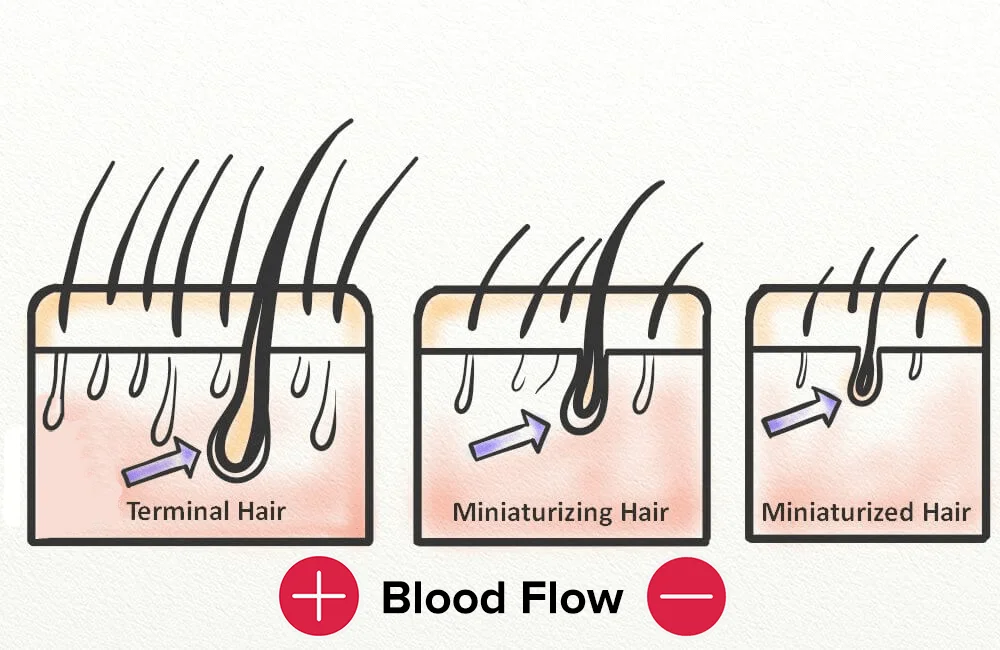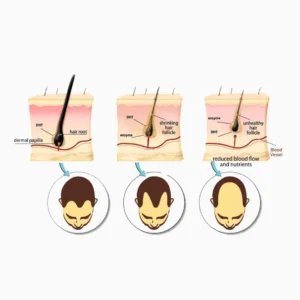Learn the Importance of Blood Flow for Hair Growth
Hair loss encompasses a spectrum of conditions ranging from age-related thinning to hereditary alopecia. Despite its prevalence, the intricacies underlying hair loss remain unclear, prompting research into its multifaceted causes. Recent scientific research has shed light on the pivotal role of blood flow dynamics in the health and vitality of hair follicles. The intricate network of blood vessels supplying nutrients and oxygen to the hair follicles not only sustains their growth but also influences their susceptibility to damage and eventual demise. As we go deeper into the intricate interplay between vascular perfusion and hair follicle physiology, unraveling the cause of hair loss emerges as a promising frontier in biomedical research.
PHYSIOLOGY OF HAIR GROWTH
The physiology of hair growth is a complex process intricately intertwined with the dynamics of blood flow. Understanding this interplay necessitates a grasp of the hair growth cycle, a recurring sequence comprising distinct phases: anagen, catagen, and telogen. During the anagen phase, the active growth stage, hair follicles undergo rapid proliferation, producing the hair shaft. This phase typically lasts several years, varying in duration depending on genetic and environmental factors. Following anagen, the follicles transition into the catagen phase, characterized by regression and cessation of growth. Finally, in the telogen phase, the follicles enter a resting state before shedding the hair shaft and recommencing the cycle.
Central to the hair growth cycle are the hair follicles, specialized structures embedded within the scalp skin. Each follicle comprises multiple layers, including the outermost epidermal sheath and the dermal papilla at its base. The dermal papilla plays a pivotal role in hair growth regulation, serving as the primary site of interaction between blood vessels and hair follicular cells. Within the dermal papilla, specialized cells receive nutrients and oxygen delivered via the bloodstream, essential for sustaining the metabolic demands of hair growth. Moreover, blood vessels supply growth factors and signaling molecules crucial for follicular proliferation and differentiation, orchestrating the intricate choreography of the hair growth cycle.
Adequate blood supply to the hair follicles is paramount for their health and vitality. The microvasculature surrounding the follicles ensures the delivery of oxygen, nutrients, and regulatory molecules essential for cellular metabolism and proliferation. Insufficient blood flow, whether due to systemic conditions, aging, or genetic predispositions, can compromise follicular function, leading to hair thinning, miniaturization, and eventual loss. Furthermore, impaired blood circulation may disrupt the delicate balance of growth factors and cytokines within the follicular microenvironment, predisposing follicles to inflammatory and degenerative processes. Thus, optimizing blood flow to the scalp is crucial for maintaining healthy hair follicles and preserving the integrity of the hair growth cycle.
BLOOD FLOW AND HAIR LOSS
Scientific investigations have increasingly underscored the intricate relationship between blood flow and hair loss, shedding light on the mechanisms by which poor circulation contributes to follicular dysfunction and eventual hair thinning or loss. Several studies have demonstrated a significant association between compromised blood flow to the scalp and various forms of hair loss. For instance, research utilizing advanced imaging techniques such as laser Doppler flowmetry and capillaroscopy has revealed diminished blood perfusion in the scalps of individuals experiencing hair loss compared to those with healthy hair growth. These findings highlight the potential role of impaired circulation as a contributing factor to hair follicle pathology.

The mechanisms underlying the detrimental effects of reduced blood flow on hair follicles are multifaceted. Insufficient perfusion deprives follicular cells of oxygen and essential nutrients, impairing their metabolic functions and compromising their viability. Moreover, compromised blood circulation hampers the removal of metabolic waste products and toxins, further exacerbating cellular stress and damage within the follicular microenvironment. Additionally, inadequate blood flow disrupts the delicate balance of growth factors, cytokines, and hormonal signals crucial for regulating follicular proliferation, differentiation, and cycling, thereby predisposing follicles to premature regression and eventual hair loss.
Conditions such as alopecia and pattern baldness exert profound effects on the blood circulation of the scalp, exacerbating the risk of hair follicle damage and loss. Alopecia, encompassing a spectrum of autoimmune, inflammatory, and hormonal disorders, often manifests with alterations in scalp microcirculation. In conditions like alopecia areata, immune-mediated inflammation targeting hair follicles can disrupt vascular function, leading to ischemia and subsequent follicular miniaturization. Similarly, pattern baldness, characterized by progressive hair thinning and balding, is associated with alterations in scalp blood flow dynamics. Studies have documented reduced blood perfusion in balding scalp regions compared to non-balding areas, suggesting a contributory role of impaired circulation in the pathogenesis of pattern hair loss.
Overall, the intricate interplay between blood flow and hair loss underscores the importance of optimizing scalp microcirculation for maintaining healthy hair follicles and preserving hair growth. Further elucidating the mechanisms underlying this relationship holds promise for developing targeted interventions aimed at enhancing blood perfusion and mitigating the impact of circulatory disturbances on hair health.
IMPROVING BLOOD FLOW FOR HAIR HEALTH
Improving blood flow to the scalp is paramount for promoting hair health and mitigating the risk of hair loss. Lifestyle factors play a crucial role in modulating blood circulation, exerting profound effects on scalp microvascular function and follicular vitality. Engaging in regular physical activity, such as aerobic exercises and strength training, enhances cardiovascular health and promotes efficient blood flow throughout the body, including the scalp. Furthermore, maintaining a balanced diet rich in nutrients essential for vascular health, such as omega-3 fatty acids, antioxidants, and vitamins, supports optimal blood perfusion to the hair follicles. Conversely, unhealthy lifestyle habits like smoking, excessive alcohol consumption, and poor dietary choices can impair vascular function and exacerbate the risk of hair loss by compromising blood flow to the scalp.

Several strategies can be employed to improve blood flow to the scalp and nurture healthy hair follicles. Scalp massage, for instance, has been shown to stimulate blood circulation and promote follicular health by enhancing the delivery of nutrients and oxygen to the hair roots. Gentle massage techniques, performed regularly using fingertips or specialized scalp massage devices, can help alleviate tension, improve lymphatic drainage, and enhance microvascular perfusion in the scalp tissues. Additionally, incorporating scalp-friendly ingredients like peppermint oil, rosemary extract, and essential fatty acids into hair care products may further augment the vasodilatory effects and promote scalp microcirculation, fostering an optimal environment for hair growth.
In addition to lifestyle modifications and home remedies, medical treatments targeting blood flow represent promising interventions for preventing and treating hair loss. Topical formulations containing vasodilators such as minoxidil have demonstrated efficacy in promoting hair regrowth by enhancing blood perfusion to the scalp and stimulating follicular proliferation. Similarly, low-level laser therapy (LLLT) devices, which emit specific wavelengths of light to stimulate cellular activity and vasodilation, have been shown to improve scalp blood flow and promote hair growth in individuals with various forms of alopecia. Moreover, emerging therapeutic modalities such as platelet-rich plasma (PRP) injections harness the regenerative potential of autologous growth factors to enhance blood circulation, rejuvenate hair follicles, and stimulate hair regrowth in individuals with hair loss conditions. By addressing underlying vascular insufficiencies and optimizing scalp microcirculation, these medical treatments offer promising avenues for restoring hair health and combating the effects of hair loss.
THE FUTURE OF HAIR LOSS TREATMENTS WITH BLOOD FLOW REGULATION
The future of hair loss treatments holds great promise, with a burgeoning focus on innovations in blood flow regulation to rejuvenate hair follicles and promote hair growth. Emerging research and technologies are increasingly emphasizing the importance of optimizing scalp microcirculation as a pivotal strategy for addressing hair loss. Advanced imaging techniques and computational models are enabling researchers to gain unprecedented insights into the dynamic interplay between blood flow dynamics, follicular physiology, and hair growth patterns. By elucidating the intricate mechanisms governing vascular regulation in the scalp, these cutting-edge approaches are paving the way for the development of targeted interventions aimed at enhancing blood circulation and fostering a conducive environment for robust hair follicle function.
Regenerative medicine holds immense potential for revolutionizing hair loss treatments by harnessing the regenerative capacity of stem cells, growth factors, and tissue engineering techniques to restore vascular function and promote hair growth. Novel approaches such as adipose-derived stem cell therapy and platelet-rich plasma (PRP) injections are gaining traction as promising strategies for enhancing blood flow to the scalp, rejuvenating damaged follicles, and stimulating hair regrowth. These regenerative modalities leverage the regenerative potential of autologous cellular components and bioactive molecules to promote angiogenesis, improve tissue perfusion, and enhance follicular viability, offering a promising avenue for individuals seeking safe and effective solutions for hair loss.
Gene therapy holds tremendous promise as a revolutionary approach for addressing blood flow-related hair loss by targeting underlying genetic factors implicated in vascular insufficiencies and follicular dysfunction. By modulating the expression of genes involved in angiogenesis, vasculogenesis, and vascular homeostasis, gene therapy interventions can potentially restore physiological blood flow patterns to the scalp, rejuvenate dormant follicles, and stimulate robust hair growth. Recent advancements in gene editing technologies, such as CRISPR-Cas9, are opening up exciting possibilities for precise and targeted manipulation of gene expression to correct genetic aberrations underlying hair loss disorders. As research in gene therapy continues to evolve, the prospect of personalized gene-based interventions tailored to individual genetic profiles holds immense promise for revolutionizing the landscape of hair loss treatments and ushering in a new era of regenerative medicine.
CONCLUSION
The intricate relationship between blood flow and hair loss underscores the importance of optimizing scalp microcirculation for maintaining healthy hair follicles and preserving hair growth. Scientific investigations have illuminated the multifaceted mechanisms by which compromised blood circulation contributes to follicular dysfunction and eventual hair thinning or loss. Lifestyle modifications, scalp massage, and medical treatments targeting blood flow represent promising strategies for improving scalp microcirculation and nurturing healthy hair follicles. Furthermore, emerging research in regenerative medicine and gene therapy offers exciting possibilities for addressing blood flow-related hair loss at the molecular level, heralding a new era of personalized and targeted interventions. By unraveling the complexities of blood flow dynamics in the context of hair health, we are poised to unlock innovative solutions for combating hair loss and restoring confidence to individuals worldwide.
SHOP FOR HAIR LOSS TREATMENTS


